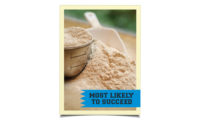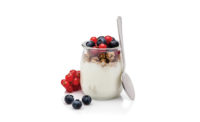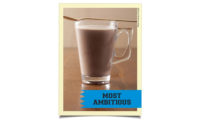If you were hoping that this clean label thing would have blown over by now, you can keep hoping. Or just throw in the towel and accept it.
Milk | Cheese | Cultured | Ice Cream | Butter | Non-dairy Beverages | Ingredients | Exports
Market researchers Innova found that in the dairy sector, items with one or more clean-label claims accounted for 49% of 2016’s launches to date, up from 41% in 2015. Innova counted claims related to natural, organic, non-GMO or no-preservatives/additives.
While simplified labels may be the goal of clean formulation, there’s nothing simple about getting there. Dan Grazaitis of TIC Gums said that as more staple ingredients fall “under the clean-label microscope,” dairy developers find themselves both feeling pressure from consumers and “looking for practical, cost-effective solutions that perform the desired functions in applications.”
There’s the rub. Clean-label formulation can’t come at the expense of functionality. That makes it difficult to meet the Food & Drug Administration’s requirement (set to take effect in July 2018) that Nutrition Facts panels dedicate a line item to added sugars. Despite the fact that reducing added sugars isn’t a clean-labeling quandary per se (consumers largely view “sugar” as “clean”), the exigencies of cutting added sugars certainly present clean-ingredient issues.
Consider the role of synthetic low- and zero-calorie sweeteners. Though they may successfully trim a formulation’s added sugars, they just as successfully “scare off consumers because of the non-clean and–clear labels they create,” said Thom King, president and CEO of Steviva Ingredients. Broadening the dilemma is the condition that any sugar alternative must not only replace sugar cleanly, but also seamlessly with no changes to taste or product performance.
In light of sugar’s legendary functionality, that’s often been a tall order. Stevia is a “natural” high-intensity sweetener extracted from the leaves of the Stevia rebaudiana plant. It provides developers a label-friendly sugar substitute. But its taste profile — slower in onset and tending toward licorice-like off notes — has somewhat thwarted its utility.
“In dairy, there’s a big need for upfront sweetness and the suppression of sweet linger,” said John Martin of PureCircle.
He said he expects that in 2017 dairy formulators will tap stevia ingredients as flavor enhancers, “leveraging their synergies to provide not only sweetness, but to boost flavors within a formula;” for instance vanilla, French vanilla and mocha.
Another natural sweetener getting attention is allulose. As a sugar, it offers little help in lowering added sugar levels. But because the body doesn’t metabolize allulose, it escapes conversion to glucose and thus provides almost no caloric energy. To wit, studies show that it yields 90% fewer calories than fully metabolized sugars while exerting no impact on blood glucose or insulin levels.
Dairy developers concerned primarily with clean-label calorie reduction will understand allulose’s appeal. Even more appealing, its taste and texture are almost indistinguishable from sugar’s. According to Yuma Tani of Matsutani Chemical Industry, the ingredient is a handy stand-in for sucrose in ice cream and yogurt, where it reduces calories “without sacrificing the original sweet taste.”
While “no single ingredient can fully replace sucrose,” Tani said, “we look forward to the increasing use of sweeteners like allulose so that dairy manufacturers can achieve low-calorie and less-added-sugar products that remain tasty.”
Steviva’s King predicts that sweeteners will appear more frequently in “systems” that address functionality along with clean calorie- and added-sugar reduction. His company is directing research into designing sweetening systems that include hydrocolloids to address mouthfeel and viscosity. Case in point: a chocolate milk that achieves sugar reduction with erythritol, monk fruit extract and stevia alone would display “a thinner, less viscous mouthfeel that may be foreign to consumers,” King said.
Incorporating natural hydrocolloids and inulin (which he called “a great fat emulator”) into the system would improve mouthfeel and flavor both and inulin has the health benefit of being a prebiotic fiber, he said.
Clean bill of health
With consumers putting a higher priority on ingredients that pay health dividends, that benefit stands to grow. Ross White of FMC Health and Nutrition said that as clean-label demand matures, “consumers will be looking for fewer ingredients but will expect those ingredients to deliver a physiological benefit. That is, they’ll be looking for ingredients with added nutritional value.”
Take probiotics, for example. Though hardly new to the health-and-wellness space, “probiotics are being singled out for their inherent health benefits” and “proclaimed on labels,” White said.
Claus Andersen of Arla Foods Ingredients said “the big winners in the dairy market will be those that can innovate by tapping the as-yet-unmet needs of underserved consumer demographics.”
Such demographics include not only athletes pursuing elevated performance, but seniors hoping to extend their active years. For both groups, “dairy proteins are a perfect fit,” Andersen said.
However, as TIC Gums’ Grazaitis cautioned, high-protein or dairy-based beverages face the challenges of shelf stability and consumer appeal.
“Some protein sources used in dairy-based formulations create strong astringency or texture defects,” he noted. Others tend to settle as sediment on a bottle’s bottom.
While hydrocolloids have proven their mettle at “combatting the negative effects that nutritional ingredients have on texture and stability,” Grazaitis said, today’s developers need hydrocolloids “that meet clean-label requirements while also providing excellent emulsification, texture and shelf stability in a wide range of dairy products.”
Gum acacia is the rare natural emulsifier because it is derived from tree sap. Grazaitis said it has yet to reach its full potential as an emulsifier and wagers that novel hydrocolloid blends will include it to “allow for stable beverage emulsions with high oil loads and no large increases in viscosity.”
The plot thickens
So how else can dairy developers build, modify and maintain texture without mucking up a label’s cleanliness? In more ways than they’d imagined, it turns out. Take carrageenan, which White offers as being able to meet today’s clean-texture challenges “more effectively than other options like guar gum or gellan gum, particularly in dairy applications” — like chocolate milk, where’s it’s long been a frequent flyer.
Judy Whaley at Tate & Lyle noted that of the top five starches appearing in clean-label products from 2010 to 2015, tapioca-based options witnessed the fastest growth, with a 27% average increase in new-product launches, according to a 2015 Innova analysis.
Unlike native tapioca starches that break down under heat and shear, new versions stand up to harsh conditions and lend functionalities similar to those of modified tapioca starches. One ingredient thickens into a soft, translucent gel that is desirable in applications such as yogurt, Whaley said.
Cultural exchange
When it comes to conferring clean texture, though, Didier Carcano of DuPont Nutrition & Health, New Century, Kan., suggests that dairy developers explore options beyond traditional starches and gums. Take cultures, for example.
“Consumer demand for natural and clean-label yogurt increases the global demand for texturizing yogurt cultures, which can deliver a premium, creamy texture in the absence of starch and added texturizing ingredients,” he said.
Carcano also is bullish on rising demand for “a broader biodiversity of cultures used in fermented dairy products with an identified origin and well-characterized identity,” he said.
Mark Cornthwaite, Carcano’s colleague and a member of DuPont’s dairy-industry marketing team, said “taste and value for money are still the biggest drivers of purchase.” Balancing those factors with clean labeling, he said, “means that dairy developers have to be skilled acrobats.”
Watch your step.
What’s the industry talking about?
- Simplified labels aren’t simple to do
- Maintaining taste, texture during reformulation
- Added sugars on Nutrition Facts panels
- Alternative sweeteners
- Adding ingredients with nutritional values
- Shelf-stability of protein drinks
- Choosing proper starches, emulsifiers
- Using cultures to build texture
Milk | Cheese | Cultured | Ice Cream | Butter | Non-dairy Beverages | Ingredients | Exports



